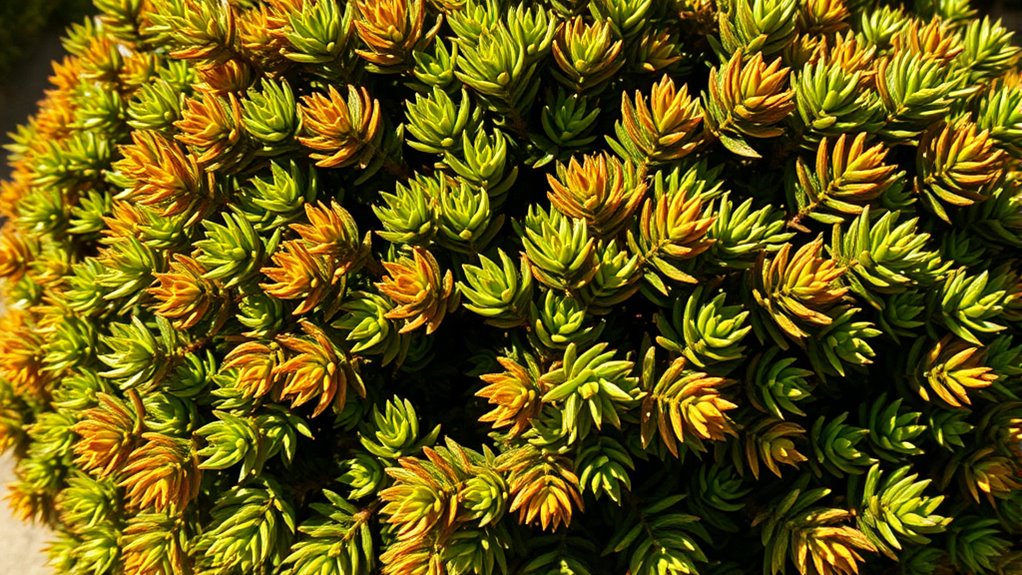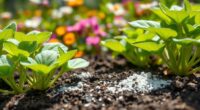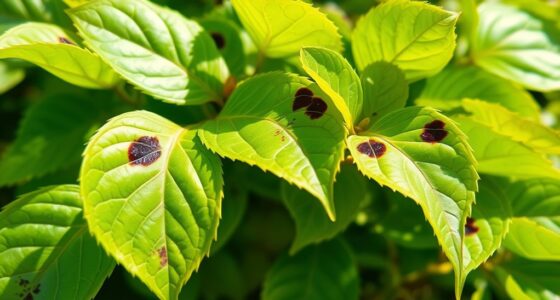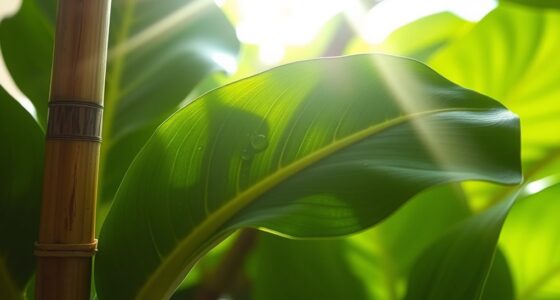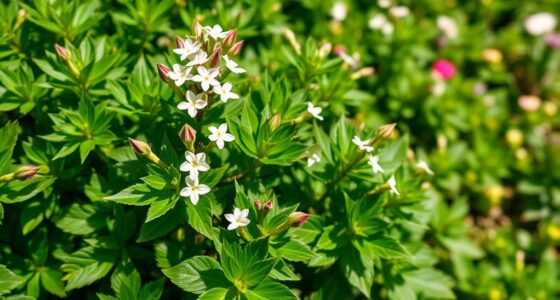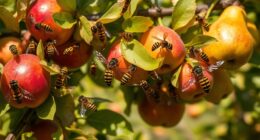If your Cryptomeria Globosa Nana is turning brown, it’s likely caused by environmental stress, improper watering, poor soil drainage, pests, or nutrient deficiencies. Overexposure to sun, wind, or temperature swings can scorch the foliage, while inconsistent watering can lead to dehydration or root rot. Soil imbalances and pests also weaken the plant, causing browning. To restore its health and prevent future issues, you’ll find essential fixes and care tips in the following details.
Key Takeaways
- Browning often results from environmental stress, such as sunburn, wind damage, or temperature fluctuations.
- Poor drainage and improper watering—either overwatering or underwatering—contribute to root rot and dehydration.
- Nutrient deficiencies like iron or magnesium deficiency cause discoloration, which can be corrected with soil amendments.
- Pests and fungal infections weaken foliage, leading to browning; early detection and treatment are essential.
- Maintaining proper soil pH, consistent watering, and regular pruning help prevent future browning and promote plant health.
Understanding the Natural Lifecycle of Cryptomeria Globosa Nana
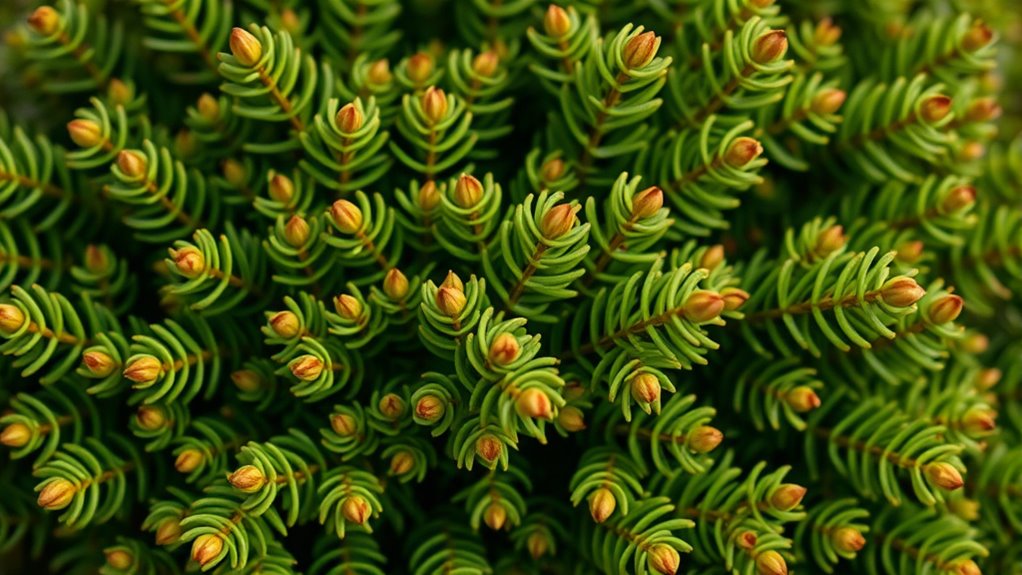
Understanding the natural lifecycle of Cryptomeria Globosa Nana is essential to caring for this unique dwarf conifer. As it matures, you’ll notice it maintains a compact, rounded shape, requiring occasional pruning to preserve its form. Use gentle pruning techniques, removing dead or overcrowded branches to promote healthy growth and airflow. Regular pest control is also crucial, as pests like aphids or scale insects can weaken the plant or cause browning. Keep an eye out for early signs of pest activity and treat infestations promptly with appropriate methods. Knowing its lifecycle helps you anticipate growth patterns and manage stressors effectively. Proper pruning and pest control ensure your Cryptomeria Globosa Nana remains healthy, vibrant, and true to its miniature, ornamental appeal.
Signs and Symptoms of Browning in Your Miniature Cedar

You’ll notice your miniature cedar starting to show signs of distress through discoloration and leaf loss. Keep an eye on the browning pattern and how it spreads across the plant, as this can indicate underlying issues. Additionally, if your plant appears weak overall, it’s a clear sign that the browning is affecting its health. Recognizing plant health indicators can help you diagnose and address the problem early. Monitoring watering habits is essential, as improper watering can contribute to browning and decline. Being attentive to soil conditions and ensuring proper drainage can also prevent further stress on your miniature cedar.
Discoloration and Leaf Loss
When your Cryptomeria Globosa Nana starts turning brown, one of the most noticeable signs is discoloration and leaf loss. You’ll see some needles fade from vibrant green to dull or brown, and patches may fall away altogether. This indicates stress or damage that needs addressing. To manage this, use proper pruning techniques to remove dead or diseased foliage, promoting healthy growth. Regular pest management is also essential, as pests like spider mites or scale insects can cause leaf discoloration and loss. Keep an eye out for signs of infestation, and treat promptly with appropriate methods. Maintaining good airflow and avoiding overwatering can help prevent further issues. Staying vigilant ensures your miniature cedar stays healthy and retains its lush, green appearance. Additionally, understanding the importance of space and organization can help you create a healthier environment for your plants by reducing clutter and improving airflow around your greenery.
Browning Pattern and Spread
Browning in your Cryptomeria Globosa Nana often starts to take shape in specific patterns that can help you identify the underlying issue. If the browning begins at the tips and gradually spreads inward, it may indicate environmental stress or improper watering. A sudden, patchy spread suggests pest problems, making pest identification vital. Observe whether the browning follows a linear or irregular pattern, as this can point to specific causes. Pruning techniques can help contain the damage, removing affected branches to prevent further spread. Pay close attention to the pattern of browning, as it provides clues about whether pests or other stressors are at play. Recognizing these signs early allows you to take targeted action before the condition worsens. Additionally, inspecting the storage conditions of your essential oils can help prevent further stress on your plant caused by chemical exposure.
Overall Plant Weakness
Overall plant weakness often manifests as widespread browning that affects large areas of your Cryptomeria Globosa Nana, signaling underlying health issues. When the plant’s roots struggle to absorb nutrients due to improper soil acidity, its overall vigor diminishes, making it more susceptible to browning. Soil that’s too acidic or alkaline can weaken the plant’s defenses, reducing pest resistance and increasing vulnerability to pests and diseases. You may notice the browning spreading unevenly or affecting the plant’s overall density. Weak plants lack the energy to maintain healthy foliage, making browning more prominent. Addressing soil conditions and ensuring proper pH levels can help restore strength. Improving soil health and pest resistance is essential for revitalizing your miniature cedar’s overall robustness. Additionally, regular monitoring and soil testing can help identify specific deficiencies and prevent further decline. Proper soil pH balance is crucial for maintaining plant health and preventing browning. Incorporating aesthetic wall organization techniques in your garden or outdoor space can also promote better plant health by creating a more structured environment that reduces stress on the plants.
Common Watering Issues That Cause Browning

One of the most common causes of browning in Cryptomeria Globosa Nana is improper watering practices. Overwatering can lead to root rot, while underwatering stresses the plant, causing browning tips. To avoid this, monitor soil moisture closely. Here are key issues to watch for:
- Watering too frequently, leading to soggy soil.
- neglecting pruning techniques that improve airflow and reduce disease risk.
- Ignoring pest control, which can weaken roots and exacerbate watering problems.
- Watering at inconsistent times, causing stress to the plant.
- Failing to consider water management practices, which highlight the importance of proper watering routines for overall plant health.
Proper watering techniques, combined with regular pruning and pest control, help maintain healthy roots and vibrant foliage. Consistency and attentiveness are essential to prevent browning caused by watering mistakes.
The Impact of Soil Conditions and Drainage Problems
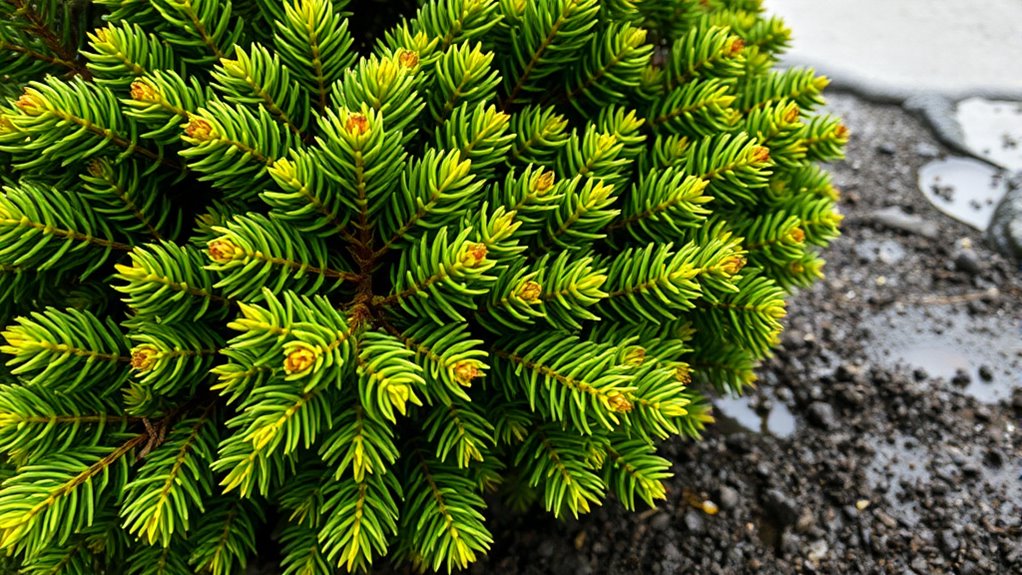
Poor soil conditions, like an imbalanced pH, can stress your Cryptomeria Globosa Nana and cause browning. If the drainage isn’t adequate, excess water pools around the roots, leading to root rot and leaf discoloration. Addressing these issues can help restore your plant’s health and prevent further damage. Ensuring proper soil compatibility can significantly improve your plant’s resilience. Using self-watering plant pots with appropriate watering regulation can help maintain optimal moisture levels and prevent overwatering or underwatering. Regularly checking your soil’s nutrient levels can further promote healthy growth and prevent deficiencies that contribute to browning.
Soil Ph Imbalance
When soil pH levels fall outside the ideal range for Cryptomeria Globosa Nana, it can cause health issues like browning and poor growth. A soil pH imbalance affects nutrient availability, making essential minerals harder for your plant to absorb. Proper soil testing can help identify pH issues early on. Consider these factors: 1. Acidic soil (pH below 5.5) can lock out nutrients like calcium and magnesium. 2. Alkaline soil (pH above 6.5) can limit iron and manganese absorption. 3. Poor soil testing can hide pH issues, leading to untreated imbalances. 4. Adjusting pH with amendments like sulfur or lime helps restore proper nutrient uptake and overall health. Maintaining the correct soil pH guarantees your Cryptomeria Globosa Nana gets the nutrients it needs to stay vibrant and healthy. Additionally, understanding soil conditions can help prevent drainage problems that contribute to pH imbalance and plant stress.
Poor Water Drainage
Soil that doesn’t drain well can quickly lead to root rot and other health issues in your Cryptomeria Globosa Nana. Poor drainage causes water to pool around roots, suffocating them and preventing proper root aeration. This increases the risk of fungal infections and attracts pests that thrive in damp conditions. To fix this, improve soil drainage by mixing in organic matter or sand to loosen compacted soil. Ensuring good root aeration allows roots to access oxygen, promoting healthy growth. Regularly check for signs of pests, which often take advantage of overly wet soil. Proper watering practices and soil amendments help maintain efficient drainage, reducing stress on your plant and supporting its overall health. Addressing drainage problems is essential for vibrant, green foliage.
How Pests and Diseases Contribute to Browning
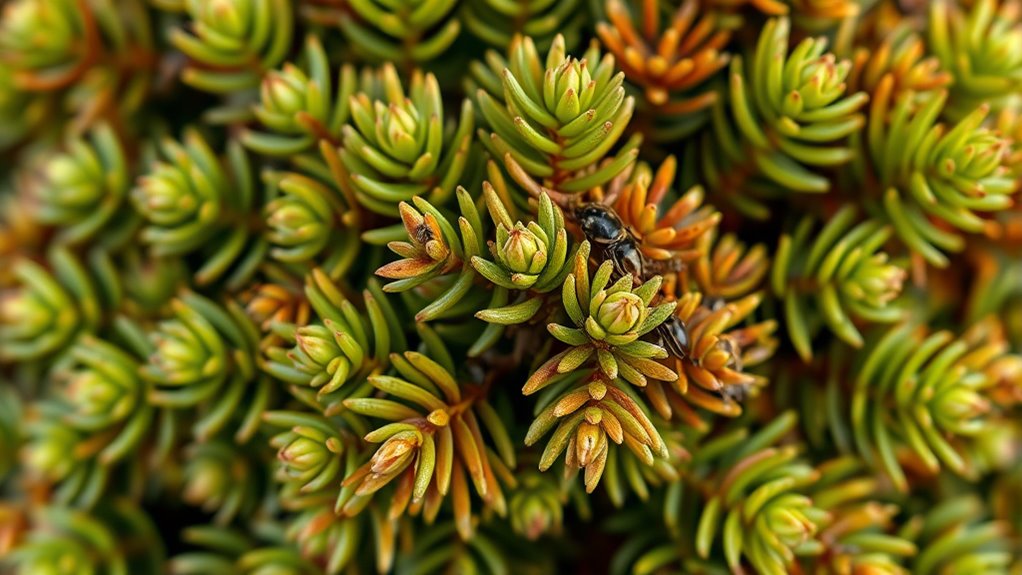
Pests and diseases can considerably accelerate the browning of Cryptomeria Globosa Nana by attacking its foliage and stems. When pests like aphids or scale insects infest your plant, they feed on the sap, weakening the foliage and causing discoloration. Fungal infections, such as root rot or needle blight, can also damage tissues, leading to browning and dieback. To protect your plant, focus on pest identification early, so you can remove or treat pests before they spread. Regularly inspect your Cryptomeria for signs of trouble. Practice disease prevention by maintaining proper airflow, avoiding overwatering, and removing affected parts promptly. Staying vigilant helps keep pests and diseases at bay, preserving your plant’s vibrant green appearance(plant health monitoring). Incorporating automation technologies can also assist in monitoring plant health more efficiently.
Environmental Stresses: Sun, Wind, and Temperature Effects

Environmental stresses like excessive sun exposure, strong winds, and temperature fluctuations can directly cause Cryptomeria Globosa Nana to brown. Sun scorch happens when intense sunlight burns the foliage, leading to browning and leaf scorch. Wind damage can physically stress the plant, causing dehydration and tearing of fragile branches or needles. Sudden temperature drops or extreme heat can also stress the plant, making it harder to retain moisture and resulting in browning tips. If your plant faces prolonged exposure to harsh conditions, it may struggle to recover. Protect it from direct, harsh sunlight during peak hours, and shield it from strong winds with windbreaks or strategic planting. Managing these environmental stresses helps keep your Cryptomeria healthy and vibrant. Additionally, understanding the different beach environments and their varying weather conditions can help you anticipate and mitigate potential stressors for your landscape plants. Recognizing environmental stressors early allows for prompt action to prevent long-term damage and supports the plant’s resilience, especially when considering climate variations that can impact overall plant health.
Nutrient Deficiencies and Overfertilization Risks
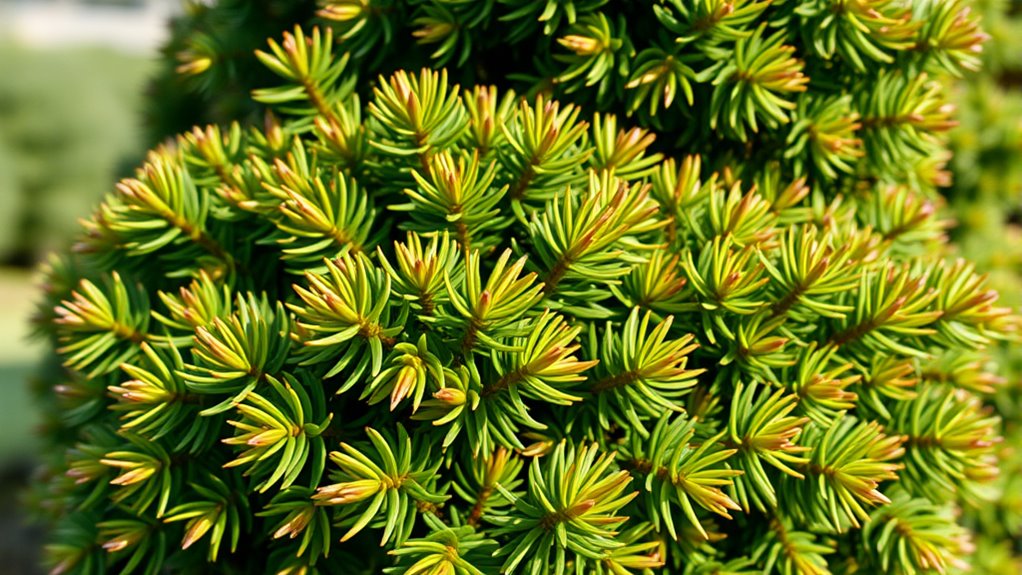
Nutrient deficiencies can cause Cryptomeria Globosa Nana to turn brown, especially if essential elements like nitrogen, iron, or magnesium are lacking. When this happens, your tree struggles to produce healthy green foliage. To address this, consider these steps:
- Use soil amendments rich in missing nutrients to restore balance.
- Avoid overfertilization, which can lead to salt buildup and root damage.
- Perform gentle root pruning to improve nutrient uptake and prevent root crowding.
- Regularly test soil to monitor nutrient levels and adjust fertilization accordingly.
Proper Care and Maintenance Practices to Prevent Browning
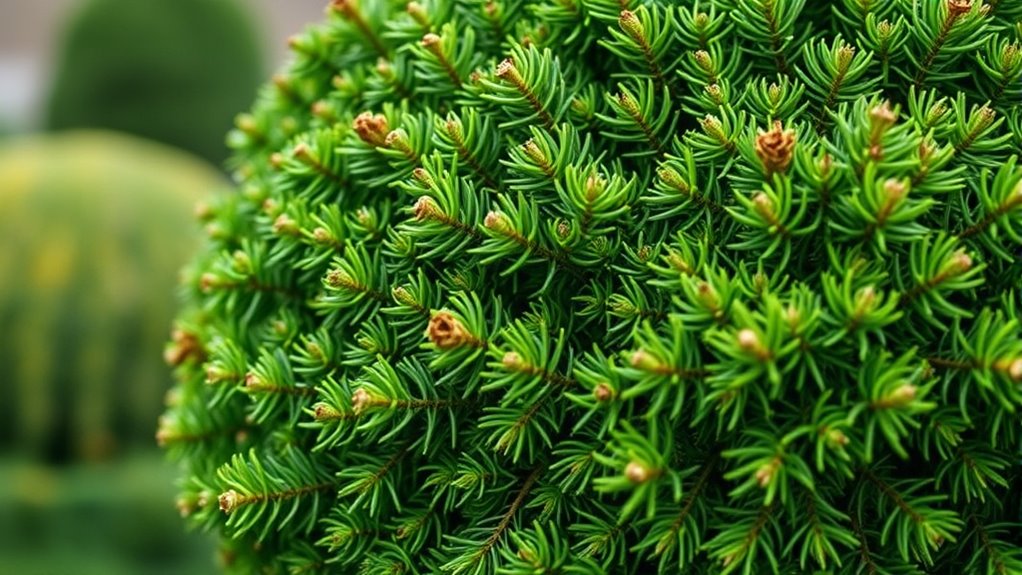
To prevent browning, you need to water your Cryptomeria globosa nana properly, ensuring the soil stays moist but not waterlogged. Make sure it gets enough sunlight each day, ideally around 4-6 hours of bright, indirect light. Additionally, follow a regular fertilization schedule to supply essential nutrients without overdoing it.
Watering Techniques Correctly
Proper watering is essential to prevent the Cryptomeria Globosa Nana from turning brown. Overwatering or underwatering can stress the plant, making it vulnerable to pests and disease. To water correctly, consider these steps:
- Water deeply once a week, ensuring the soil stays moist but not soggy.
- Check soil moisture with your finger; water only when the top inch feels dry.
- Mulch around the base to retain moisture and regulate soil temperature.
- Adjust watering frequency during hot or rainy periods to avoid overhydration or dehydration.
Consistent watering supports healthy growth, reducing the need for excessive pruning techniques. Proper watering also minimizes pest issues, helping your plant stay vibrant and green.
Adequate Sunlight Exposure
Ensuring your Cryptomeria Globosa Nana receives adequate sunlight is essential for preventing browning and maintaining its vibrant green color. Place it where it gets plenty of direct sunlight or filtered light throughout the day. Proper pruning techniques help improve airflow and light penetration, reducing stress and disease risk. Be cautious not to over-prune, which can weaken the plant. Regular pest management is also vital, as pests like spider mites and scale insects can damage leaves and inhibit photosynthesis, leading to browning. Keep an eye out for signs of pests and treat infestations promptly. By providing sufficient sunlight, practicing proper pruning, and managing pests effectively, you’ll help your Cryptomeria stay healthy, lush, and green.
Fertilization Schedules Regular
Regular fertilization is key to keeping your Cryptomeria Globosa Nana healthy and vibrant. Following a consistent fertilization schedule guarantees your plant receives the right nutrient balance to prevent browning. To achieve this, consider these practices:
- Apply a balanced, slow-release fertilizer in early spring and mid-summer.
- Use a liquid fertilizer every 4-6 weeks during the growing season.
- Avoid over-fertilizing, which can cause nutrient imbalances and stress.
- Adjust fertilization based on the plant’s growth and soil conditions.
Tips for Reviving a Browning Cryptomeria Globosa Nana

When you notice your Cryptomeria Globosa Nana turning brown, acting quickly can help revive its health. Start by inspecting the plant for dead or damaged branches and use proper pruning techniques to remove these areas. Pruning encourages healthy growth and improves airflow, reducing the risk of disease. Additionally, check for pests like scale or mites, which can cause browning; if you spot any, treat the plant with appropriate pest prevention methods. Keep the soil evenly moist but not waterlogged, and make certain the plant gets adequate sunlight. Avoid over-fertilizing, which can stress the tree further. Regularly monitor your Cryptomeria for signs of stress or pests, and act promptly to sustain its vitality and prevent further browning.
Preventative Measures for Long-Term Health of Your Miniature Cedar
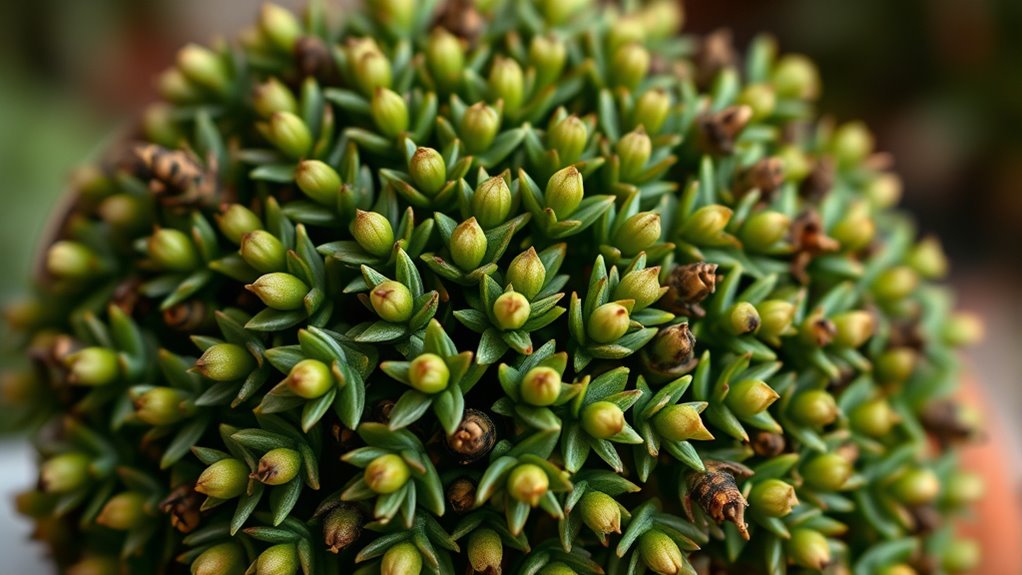
To keep your Cryptomeria Globosa Nana healthy over the long term, adopting proactive care practices is essential. Proper pruning techniques help maintain its shape and remove dead or diseased branches, preventing stress. Regular pest management involves inspecting for signs of insects or disease and applying appropriate treatments promptly. Additionally, guarantee your miniature cedar is planted in well-draining soil to avoid root rot. Consistent watering, especially during dry periods, supports healthy growth. Mulching around the base conserves moisture and suppresses weeds. Ultimately, monitor environmental conditions, avoiding extreme temperatures and harsh winds. By implementing these measures, you promote a resilient, vibrant miniature cedar that stays healthy and attractive for years to come.
Frequently Asked Questions
Can Browning Be Caused by Root Rot in Cryptomeria Globosa Nana?
Yes, browning can be caused by root rot in Cryptomeria globosa nana. Poor soil drainage creates soggy conditions that promote root rot, leading to browning and dieback. Additionally, pest infestations can weaken roots and hinder nutrient uptake, worsening browning symptoms. To prevent this, guarantee proper soil drainage and monitor for pests. Addressing these issues promptly helps keep your plant healthy and vibrant.
How Does Humidity Affect the Browning of This Miniature Cedar?
You might think humidity doesn’t affect your miniature cedar, but it actually has a big impact on browning. High humidity increases moisture levels around the plant, preventing dehydration and helping it stay healthy. Conversely, low humidity causes moisture loss, leading to browning and stress. Maintaining ideal humidity ensures proper moisture balance, supporting your cedar’s vibrant green foliage and overall health. Keep an eye on humidity impact to keep your plant thriving.
Are There Specific Fertilizers That Prevent Browning Issues?
You should focus on selecting the right fertilizer that promotes healthy growth and prevents browning. Look for fertilizers with a balanced nutrient profile, especially those rich in nitrogen, phosphorus, and potassium. Proper fertilizer selection helps maintain the nutrient balance your miniature cedar needs, strengthening its immune system and reducing stress. Regular feeding with a suitable fertilizer guarantees your plant receives essential nutrients, which can prevent browning and keep it vibrant and healthy.
What Are Natural Remedies to Reverse Browning Leaves?
Think of your plant’s leaves as a garden in need of gentle care. To reverse browning naturally, try DIY remedies like rinsing the leaves with water to remove dust or applying diluted neem oil as a natural pesticide. Soil treatments such as adding compost or organic mulch can improve soil health. These natural methods rejuvenate your plant’s roots and leaves, helping them recover and stay vibrant without harsh chemicals.
How Often Should I Prune to Maintain Healthy Growth?
To maintain healthy growth, you should prune your Cryptomeria Globosa Nana regularly, typically every 1 to 2 years. Proper pruning frequency encourages growth maintenance by removing dead or damaged branches and shaping the plant. Avoid over-pruning, which can stress the tree, and focus on light trimming during the growing season. Consistent, moderate pruning helps keep your plant vibrant, healthy, and well-shaped.
Conclusion
Think of your Cryptomeria Globosa Nana as a delicate garden friend—when you catch its browning early, it’s like giving it a gentle hug. I once saw a tiny cedar bounce back after adjusting watering and improving soil drainage, proving that with attentive care, even a struggling plant can thrive again. By understanding its needs and acting promptly, you’re helping your miniature cedar stay vibrant and healthy—like a loyal companion that brightens your space.
